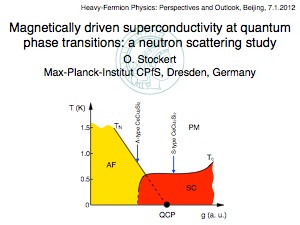Institute of Physics, Chinese Academy of Sciences


Jan 07-09, 2012

Magnetically driven superconductivity at quantum phase transitions:
a neutron scattering study
Oliver Stockert
Max-Planck-Institut für Chemische Physik fester Stoffe, 01187 Dresden, Germany
The origin of unconventional superconductivity, including high-temperature and heavy-fermion superconductivity, is still discussed controversially. Spin excitations instead of phonons are thought to be responsible for the formation of Cooper pairs. Unconventional superconductivity is quite often observed in the vicinity of a magnetic quantum critical point (QCP), i.e., a continuous magnetic phase transitions occurring at T = 0. Such a QCP in a strongly correlated metal can be approached when tuning a continuous finite temperature phase transition to occur at T = 0 by means of a non- thermal control parameter like doping, pressure or magnetic field. At the QCP these systems can no longer be described as Fermi liquids like normal metals. Instead, as a result of the quantum-critical spin fluctuations driving this T = 0 phase transition, unusual low-temperature properties are observed in thermodynamic and transport measurements. Some quantum critical systems even exhibit unconventional superconductivity at the QCP.
We report on high-resolution elastic and inelastic neutron scattering experiments to study the magnetic order and the spin dynamics in the vicinity of magnetic QCPs in heavy-fermion metals with a focus on the interplay between magnetism and superconductivity. Due to the small characteristic energy scales involved, experiments with high energy resolution are required. Starting from the heavy-fermion superconductor CeCoIn5 antiferromagnetic order is induced by Cd doping. Measurements indicate a microscopic coexistence of antiferromagnetism and superconductivity, but reveal at the same time a strong influence of the superconducting state on the magnetic order. In contrast, both phenomena exclude each other on a microscopic scale in the prototypical heavy-fermion compound CeCu2Si2. The normal state response of superconducting CeCu2Si2, located at the QCP, shows an almost critical slowing down for T → 0. Its temperature dependence and scaling behavior are in line with the expectations for an itinerant spin-density-wave QCP. This interpretation is substantiated by an analysis of specific heat data and the momentum dependence of the magnetic excitation spectrum. In contrast, the magnetic response in the super- conducting state is characterized by a spin excitation gap and a transfer of spectral weight to energies above the gap. Our results strongly imply that the coupling of Cooper pairs in CeCu2Si2 is mediated by overdamped spin fluctuations. The results will be compared with other unconventional superconductors where strong electronic correlations play an important role.

click the picture to download
contact
Yi-feng Yang, Institute of Physics, Chinese Academy of Sciences, P. O. Box 603, Beijing 100190, China. Tel: (86)-10-82649448, (86)-18911600270; Fax: (86)-10-62553698; Email: yifeng@iphy.ac.cn


